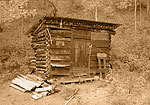



![]()
![]()
![]()
During the early part of 1897, the Black Copper Mining District was quite active, employing as many as fifty men. However, the Garners soon joined in some kind of agreement with A. T. Gunnell of Colorado which changed the ownership of the Black Copper Mine. Gunnell transferred his interest to the Taos Gold Mining and Milling Company, which was incorporated in Colorado. This company also came to include the Queen and Jubilee Lodes owned by C. E. Stubbs and Hannah Stubbs. The change in ownership somehow resulted in quarrels between the operators and owners, resulting in a slowdown of the mining operation. By summer only six men were left on the payroll. This drastic curtailment of the mining production had a chilling effect throughout the district, and was a leading cause of the failure of Franklin City. Very little work was done during the remainder of the year.
By early 1898, the disagreements were resolved and the mine resumed active production, employing up to 24 men. By the following year, the owners decided to build a mill at the mine. A hoisting plant and boiler were installed and ore was shipped to the mill in Elizabethtown to determine the optimum type of equipment to give the greatest yield. In 1900, R. Cline was appointed superintendent of the Black Copper and work progressed. By that time, the main shaft had reached a depth of 240 ft. In the fall of that year, Cline ordered the machinery for a five-stamp amalgamating mill. A site was selected, housing for the mill was put in place, and in February of 1901 the mill was complete and in operation. The impact of this event was reported in the Taos Cresset: "The success of this mill proves that we have a mining camp. Nothing has happened before that has done so much to place the Red River district on a permanent basis."
High hopes for the Black Copper Mine would soon come crashing down. The quarrels, bickering, and disagreements of 1897 would return again and this time result in closing of the mine. In spite of the spirit of optimism in the spring of 1901, later during the summer the owners stopped the mill and closed the tunnel. Reasons were not clear though the owners declared they needed to install new machinery. The miners speculated that the real reason was a struggle for control or else some form of litigation involving the owners. Whatever the issue, the mine closed, miners left the area and the Black Copper lay dormant over the next ten years.
In 1912, there was a revival of interest in mining throughout the Red River area and there is evidence that work on the Black Copper resumed about that time. There is a letter dated June, 1914 from N. H. Emmonds, a mine inspector, addressed to one of the owners, George Spencer describing conditions at the mine. He referred to certain problems and questioned the veracity of the miners and the mine supervisor. The exact situation is not known for certain but it is fairly clear that there was little if any profit from the mine during that time. In fact, there was considerable loss on the operation, for in 1916, a court found that the Taos Gold Mining and Milling Company owed Spencer over $125,000 and was in default on the loan. The Taos County sheriff was ordered to sell the property at auction and it went to Spencer for $3,000.
![]()


Stamp Mill

Mill Stamps

4-Holer Latrine

Stamp Mill

